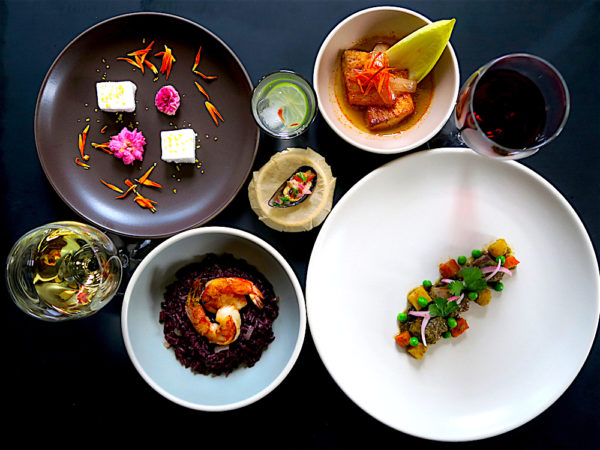Culinary inspiration can be found in many places — cookbooks, food films, dining at a new restaurant, visiting farmers markets, meeting other chefs, or following the World’s 50 Best Restaurants on social media. But nothing inspires me to cook as much as traveling, being immersed completely in another culture, and learning about it through food is an experience that stays with you forever. And after coming home from a week-long exploration of the food and cocktail culture in Tokyo, all I’ve been wanting to do is to cook.
For days, I was profoundly inspired to cook a Peruvian tasting menu that followed some of the progression and Japanese culinary traditions of a kaiseki meal — 5 colors, 5 flavors, 5 senses, and 5 methods of cooking, all of which center around a sense for shun, the peak of seasonality for ingredients. Going through this creative process completely transformed how I viewed a menu, thought about the ingredients, and plated the dishes. The result, a culinary fusion of Peruvian and Japanese cultures, is something that I am calling kaiseki criollo.
kaiseki criollo n. /ˈkīsekē krēˈōlō/ traditional Peruvian cuisine prepared and presented in a minimal and mindful kaiseki style
Criollo, of course, refers to Peruvian creole cuisine, but how can one make it more like kaiseki? That was the challenge I gave myself, and the first step was deciding which dishes to prepare. The answer came to me over a series of brainstorming sessions that are part of my menu development process. First, I sit down with my Moleskin notebook, turn to a blank page, visualize the courses and then begin to sketch the dishes, label the ingredients, and make notes, all while sipping a glass of wine, or in this case nihonshu.
During this process, my goal was to discover and distill the essence of each dish. For example, Escabeche de Pescado is traditionally large pieces of pan fried fish served with a pickling sauce, red onions, sweet potato, lettuce, hard boiled egg, and olives. Or Seco de Cordero is a hearty lamb stew often accompanied by generous servings of steamed white rice and beans. Could one remove some ingredients, make the plating as minimal as possible, but still retain the qualities that make the dish Peruvian?
To answer that question, I prepared this tasting menu for some dear friends last weekend, and I truly believe the answer is hai. Presenting, my first Kaiseki Criollo tasting menu for Spring 2016 — a culinary journey from the sea to the Andes mountains of Peru: Pisco cocktail aperitif, steamed mussel and fish soup amuse bouche, pickled fried fish with sweet potato, lamb stew with yellow potatoes and carrots, purple corn risotto with shrimp, and Pisco Sour marshmallows with edible flowers.
Kaiseki Criollo, Spring 2016 |
|
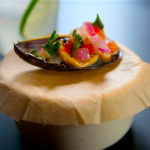
|
Amuse Bouche Sip the Chilcano de Pisco cocktail, enjoy the Choro a la Chalaca steamed mussel slider with red onion, tomato, parsley, lime juice and aji amarillo salsa, then, uncover the ramekin and drink the warm fish stock with pisco and butter that was used to steam the mussel. |
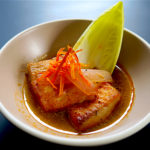
|
Escabeche de Pescado Pan fried white fish, rested in a sweet and sour pickling sauce with a red onion and aji panca sofrito, garnished with an endive and topped with fried julienned sweet potato. No eggs. No olives. Just the taste of the sea and spicy, earthy, red hot peppers. Paired with a Semillon white wine. |
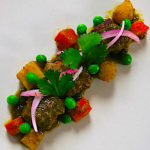
|
Seco de Cordero Lamb cubes slow cooked with yellow potatoes and carrots in a beef stock with cilantro purée and a red onion and aji amarillo sofrito, garnished with pickled red onions and green peas. No rice. No beans. Just three mindful bites representing the traditions of Northern Peru. Paired with a Tempranillo red wine. |
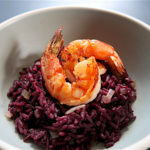
|
Risotto Andino Long grain white rice steamed with a purple corn elixir, mixed with a yellow onion and aji amarillo sofrito, and topped with shrimps a la plancha. A marriage of the purple corn from the Andes and shrimp from the sea, tied together by the lingering heat of the yellow hot peppers. |
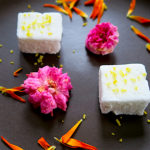
|
Pisco Sour Marshmallows A molecular mixology bite-size version of the classic cocktail, garnished with Angostura bitters on the bottom, lemon zest on top, and edible flowers. Because when you can have Pisco for dessert, you should. |
